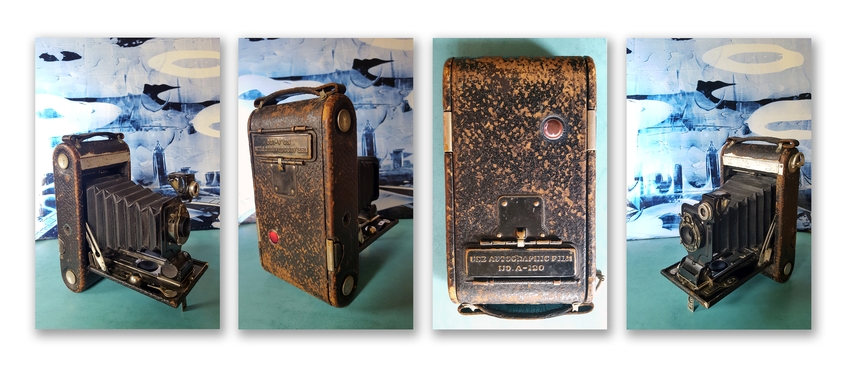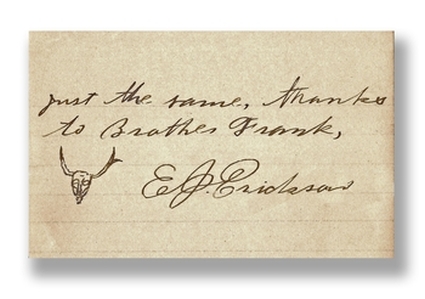Frank & Ernst Julius Erickson's 1917 Kodak Autograph Camera
A Kodak Autograph Camera kept through the ages by my Grandparents and then my Father is a treasured piece of history. It was first used in early 1917 by my Grandfather Frank and his older brother, my Uncle Ernst Julius Erickson. Though most specifically for our family, it holds in it's existence unique family adventures and photographic recollections. I received the camera from my Father Ernest Anders Erickson and he received it from his Father Frank, just as my father went off to serve combat duty with the 95th Bomb Group, in England in 1943.
My dad had mentioned the various stories connected to the camera and showed me the photographs it had taken from 1917 through the First World War. My father used it during the Second World War when he was stationed with the 95th Bomb Group at Horham Airfield. It was a marvel in capturing some unique images.
I finally decided to post this page when a friend in Holland, who I knew through our mutual interest in the Lost Battalion, contacted me. Peter and his son have visited the pocket in the Argonne Forest where my Grandfather Frank and his Company H, along with the rest of the 308th Infantry were trapped during the October 1918 'Lost Battalion' siege. Peter told me the news that he had just acquired Major General Robert Alexander's (Commander of Frank's 77th Regiment) Kodak Autograph Camera with Alexander's name monogrammed on the back of the camera. I considered that pretty cool and very coincidental, as it got me thinking that it was time to feature Frank and Ernst's camera here on the Family Archive Project website.
General Alexander along with Adjutant General Louis B. Gerow and Frank's Company H Commander, Captain William J. Cullen signed the accommodation below, which went along with Frank receiving the Silver Star in 1918.
* * * *
November 14th, 1918
General Orders No. 39
Headquarters 77th Division
I desire to record in the General Orders of this Division a tribute to
the valorous conduct of the following Officers and Enlisted Men who
have distinguished themselves by their splendid courage, service and
sacrifice:
Pvt. Frank G. S. Erickson, #3143116, Company H. 380th Infantry who
displayed extraordinary heroism in action in the ARGONNE FOREST,
near BINARVILLE, between October 3rd and October 8th, 1918, when
that Company, together with other Companies of the 1st and 2nd
Battalions of this regiment, were surrounded by the enemy and cut off
from communication with friendly troops. During this period, Pvt. Erickson
was a runner between his Company and Battalion Headquarters.
Though completely without food during all this period, he cheerfully and
courageously performed his duties as a runner. During a heavy attack by
the enemy on October 3rd, 1918, he carried messages from his company
Commander to Battalion Headquarters and Major Charles W. Whittlesey.
All of this was under heavy fire from machine guns and trench mortars,
Pvt. Erickson succeeded in delivering his messages and in guiding
supporting troops to the left flank which was then being subjected to heavy
pressure by the enemy.
On succeeding days of the siege, this soldier continued to perform his
duties over exposed places and in full view of the enemy and always under
heavy machine gun fire which raked the position on the least exposure.
These duties he performed in absolute disregard of his personal safety.
Major General Robert Alexander - Commander of the 77th Regiment
Adjutant General Louis B. Gerow
Captain William J. Cullen - Company H - 308th Infantry
American Expeditionary Force
The photographs that Frank and Brother Ernst Julius and my Father Ernest Anders Erickson took over the years with this camera, speak for themselves. The Family Archive Project website here features many. I will post a few of my favorites below. These images are a testimony of the incredible family history held in the shutter view of their camera.
With two North Dakota connections worth telling here, I will start with David Houston, who invented roll film for cameras. Houston lived near Hunter, North Dakota and his home has been restored and is now located at Bonanzaville in West Fargo, North Dakota. David Houston was born in Scotland in 1841. At a young age, he became interested in how photography worked. At that time, cameras were large and very heavy, and they used glass plates coated with chemicals instead of film. At this time the only people who owned cameras were professional photographers.
A major goal of Houstonís was to make a camera that anyone would be able to own. In 1867, he got his first patent on a camera improvement he had devised. A patent is a document, issued by the government, that gives only the inventor the right to make and sell his or her inventions. A patent protects the rights of the inventor so that no one else may copy the invention.
In 1886, Houston invented a device that totally changed photography. Instead of using bulky plates of film, this invention allowed film to be wound on rolls inside the camera. Houston sold the rights to this patent to George Eastman, another inventor. Houston received $5,000 and monthly payments from the sale of roll-film cameras for the rest of his life.
George Eastman started his own camera company and bought 21 camera patents from David Houston. Houston suggested the camera company be named after northern Dakota and called 'Nodak.' Eastman liked the suggestion, but wanted a name that did not mean anything in particular. He changed the first letter and called his company 'Kodak.'
Because of his inventions, David Houston became very wealthy. He owned a bonanza farm consisting of 4,000 acres. Many changes have been made to the Kodak camera since the time of David Houstonís inventions; however, he was the person who made it possible for anyone to own a camera.
There was David Houston's time in North Dakota and now we move fifty or so years forward, to a Kodak connection of my Father's side of the family. My Great Uncle Sture Albin Nelson Sture was born in Landskrona, Sweden on May 2nd, 1896. He and his family came to the States in 1903. He grew up along with his sister, my Grandmother Clara Amelia (Nelson) Erickson and three Brothers August Valentine, Anton Tony and Albert 'Bob' William Nelson. His parents are Gerda (Miljander) and Anders Nilsson Nelson and the entire family settled on a farm in Painted Woods, North Dakota in 1905.
Sture moved to Los Angeles, California in 1936, and starting in 1940, worked for Eastman Kodak for twenty two years. Sture was trained originally as an electrician and later became an independent photographer where he gained the skills to work for Eastman Kodak.
Second photograph taken by my Grandfather Frank below is of my Uncle Ernst Julius Alfred Erickson at the end of their Mt. Baldy, Oregon Deer Hunt taken on September 26th, 1917.
The transcription text of Ernst's Mt. Baldy, Oregon Deer Hunt (September 18th through 26th, 1917) diary entries are below also.
|


